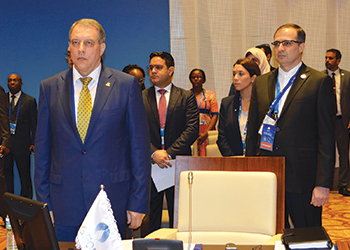
 Sentyurin at a GECF summit
Sentyurin at a GECF summit
Gas has environmental advantages over other fossil fuels, and is anticipated to gain a foothold and increase its share in the global energy mix. Demand for gas is expected to recover in 2021 with operators stepping up investment
Gas is facing uncertainty similar to oil due to decreased demand and the devastating effects of the global Covid-19 pandemic. This has significantly slowed down investments in the sector.
However, this might turn around especially as gas is being heralded as a fuel of choice for the 21st century global economy backed by its potential to achieve the UN Sustainable Development Goals and the objectives of Paris Agreement.
In this interview, Yury Sentyurin, Secretary General of the Gas Exporting Countries Forum (GECF), tells Abdulaziz Khattak of OGN of what lies ahead for gas and gas exporting countries:
How do you see the market during coronavirus? You said before, the pandemic will affect the industry?
The current economic downturn and stay-at-home restrictions, caused by the Covid-19 crisis, are affecting natural gas markets very strongly and the level of uncertainty remains high. According to our latest forecast, gas demand could drop from 3 per cent to over 6 per cent in 2020, the latter figure accounting for a possible wave of the pandemic. Concurrently, in the case of another mild winter season we can anticipate the continuation of LNG cargo cancellations as, for example, in Europe the volume of gas in storage has already reached 67 per cent of capacity. High level of gas in storage has significant downward pressure on gas prices, which affects gas suppliers.
Moreover, current low oil and gas prices as well as declines in gas consumption amidst the Covid-19 pandemic have led to a slowdown of investments in the industry. In this context, the LNG industry will be significantly affected, as Final Investments Decisions (FIDs) on more than 110 million tonnes per annum (mtpa) of capacity have already been postponed from 2020 to 2021-2022. If these conditions persist, FIDs on other LNG projects, with the original target of 2020, could also be delayed. In turn, this could influence the stability of gas markets in the mid-term (after 2025) and timely development of regasification infrastructure, as global LNG demand is projected to expand at a healthy growth rate, driven by Asia Pacific region.
Resuming, the markets are undergoing fundamental changes and its players adopting a cautious approach to cope with the new market circumstances. Nevertheless, as far as natural gas is concerned, we are confident that it will play a key role in responding to the global energy needs in the pandemic period and in post-Covid-19 economic recovery phase in which the countries will need reliable access to affordable energy sources with minimal ecological footprint. In this regard, the GECF Member Countries have always weathered shocks to the market, thanks to their competitive advantage over new exporters, and their commitment to ensure the sustainable supply of natural gas to the market.
How do you see the future of the spot market against contracts?
As an international governmental organisation, the GECF believes in the prospects of long-term contracts due to the important benefits they bring to both the buyer and the seller. From the buyers’ perspective, long-term contracts guarantee stable and sustain gas supplies for several years, which is a strong prerequisite for the development of the entire industry in the importing country. From a seller’s perspective, a long-term contract secures and sustains future investment in the gas business and ensures cash flows. This allows oil and gas companies to expand their exploration and production capacities and continue producing gas.
Moreover, the GECF member countries are committed to the long-term partnership with their customers and have always been reliable suppliers of natural gas to their customers. In fact, supporting long-term contracts is one of the stated objectives of the GECF member countries and this is stipulated in the Malabo Declaration, where heads of state and governments highlighted that the GECF members countries "support the fundamental role of long-term gas contracts as well as the gas pricing based on oil indexation, to ensure a stable investment in development of natural gas resources".
However, we are witnessing that long-term contracts with a duration of more than 20 years are no longer being observed nowadays. The new long-term contracts are typical around 10 years, which is a win-win solution for both buyers and sellers under the current market conditions.
Meanwhile, the rising trend of spot deals in the last few years has been effective in creating market flexibility for excess volumes held by traders and producers. Short-term spot prices are attractive these days due to the reasons that we all know but this is impacting the exporters. We have seen some exporters stopping their exports because of plummeting prices that do not even match the cost of production in some cases; also, some investors decided to defer FIDs that may cause shortage in the market by the second half of this decade accompanied by increase in spot prices.
Moreover, it would be pertinent to highlight that the long-term sale and purchase agreements (SPAs) dominate the overall market deals with nearly 66 per cent, which represents most of the trade in 2019. It should be pointed out as well that while the spot and short-term deals recorded significant growth between 2016 and 2019, we have observed the entry into force of many new long-term contracts in the US and Australia in 2019.
Therefore, consumers and producers, through holistic discussion, need to agree together on the way contracts should look in the future to protect them from the fluctuations of spot market.
What will happen to the policies that encourage the use of clean energy after the coronavirus pandemic?
In this difficult period, the absolute priority of policymakers is to support measures that will enable them deal with the health, social, and economic effects of the pandemic. In particular, many policies and financial resources will be targeting the recovery of the economies through the development of stimulus packages that incentivise growth and employment.
Nevertheless, we observe increasing calls and policy announcements around stimulus packages that support clean energy. The EU is leading this dynamic with the announced plan of a €750 billion ‘Next generation EU’ package, where 25 per cent is allocated to green energy and digital developments.
In our view, post-Covid-19 policy measures that aim to extensively push for clean energies, excluding hydrocarbons, will face several challenges. First, it is difficult to add new constraints, such as carbon taxes or imposition of tougher environmental standards on already weakened economies. Second, funding the green stimulus packages remains a key issue since it will amplify the debts risks and the creditworthiness of the economies. Third, the clean energy options, excluding hydrocarbons, are still facing technical and economic barriers for their deployment, which might have an effect on the competitiveness of the energy supply. Even solar and wind, which have observed decreasing costs, continue to face integration challenges and the necessity to provide backup for their intermittency.
Therefore, we believe that natural gas, even if it is a hydrocarbon source, should be considered as a clean energy and be included as a lever for economic restoration in the aftermath of the pandemic. Indeed, natural gas provides a competitive and environment-friendly source of energy and constitutes the attributes that will allow reaching a balance between the environmental, economic, and social dimensions of sustainable development.
How do you see the future of investment in the gas industry, especially considering the delay by many companies on their expansion and exploration projects? Would you have figures on investment in gas projects in the region?
The year 2020 has become an extraordinary year for the global economy, with many industries, including the gas industry, experiencing a shock because of the Covid-19 outbreak. We have witnessed the falling gas demand in many regions driven by the imposition of the lockdown measures, which, coupled with LNG oversupply, has led to historically low gas prices.
It is natural that in the context of falling gas prices, many gas operators, including international and national gas companies, have incurred losses in Q1 and Q2 of 2020. We witness the upstream companies, particularly the ones producing from unconventional plays in the US, reported huge losses in Q1 2020 and are filing for bankruptcy. In these unfavourable circumstances, market operators have had to cut their expenditures, with capital investment getting the axe first. Gas companies simply do not have sufficient cash flows to keep investment budgets at the same levels as approved before the advent of Covid-19.
All subsectors of the gas industry including upstream, midstream, and downstream, have witnessed a decline in investment flows in 2020. Many projects, with FID already taken, have had delays in implementation, and are likely to be commissioned later than previously expected. As for new projects, with FID expected to be taken in 2020-2021, several have been put on hold until the market condition improves. For instance, developers of LNG projects have faced a problem with attracting financial resources because of the inability to secure long-term supply contracts.
The low prices of oil and gas affect the feasibility of all upstream projects across the globe, but the projects with a higher cost curve are more in danger of delays or cancelations. The global investment in upstream oil and gas projects could record a 15-year low in 2020 — around 30 per cent y-o-y decrease to $386 billion in 2020, according to Rystad Energy.
Investment delays in LNG projects could limit liquefaction capacity and create a significant shortfall in production levels over the medium-term. LNG demand growth outpaces liquefaction capacity, and delays in project sanctioning will affect the development of LNG regasification infrastructure and LNG to power plant projects, especially in Asia. We should clearly understand that a lack of investment today might pose a risk to security of gas supply in the medium-term. Therefore, the plunging investment flows are an important concern not only for the gas suppliers, but also for gas consumers. It is of in the mutual interest of the buyers and the sellers to keep investment flows at the minimum required level.
However, the average breakeven price of natural gas production in the Middle East is lower than in other regions. Therefore, we expect that the upstream projects in the region to be less affected compared to the other areas of the world. Likewise, the LNG projects’ breakeven price in the Middle East producers such as Qatar is remarkably lower than their counterparts in the US and Australia. Therefore, it is forecast that the FID’s for LNG projects in the Middle East will undergo a minor postponement, and the countries in the region will remain committed to their medium-term development plans.
We might expect a rebound of gas demand in a few months, driven by the lifting up of lockdown measures in many countries and the approaching winter season. This factor, coupled with a slowdown in LNG supply growth, would entail a slight recovery of gas prices starting from 2021. As a result, the financial situation of many gas operators is expected to improve which will enable them to gradually step up investment flows, put current projects back on track, and start new projects. As for long-term prospects, the global gas industry has excellent potential to attract sufficient investments, since natural gas, which has environmental advantages over other fossil fuels, is anticipated to gain a foothold and increase its share in the global energy mix.
• Qatar will host the 6th Summit of Heads of State and Government of the GECF member countries in late 2021.



















































































